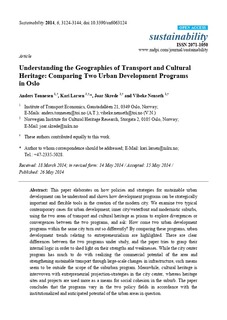| dc.contributor.author | Tønnesen, Anders | |
| dc.contributor.author | Larsen, Kari | |
| dc.contributor.author | Skrede, Joar | |
| dc.contributor.author | Nenseth, Vibeke | |
| dc.coverage.spatial | Norway | nb_NO |
| dc.date.accessioned | 2019-06-28T10:41:40Z | |
| dc.date.available | 2019-06-28T10:41:40Z | |
| dc.date.created | 2014-05-26T14:28:35Z | |
| dc.date.issued | 2014-05-26 | |
| dc.identifier.citation | Sustainability. 2014, 6 (6), 3124-3144. | nb_NO |
| dc.identifier.issn | 2071-1050 | |
| dc.identifier.uri | http://hdl.handle.net/11250/2602789 | |
| dc.description.abstract | This paper elaborates on how policies and strategies for sustainable urban development can be understood and shows how development programs can be strategically important and flexible tools in the creation of the modern city. We examine two typical contemporary cases for urban development, inner city/waterfront and modernistic suburbs, using the two areas of transport and cultural heritage as prisms to explore divergences or convergences between the two programs, and ask: How come two urban development programs within the same city turn out so differently? By comparing these programs, urban development trends relating to entrepreneurialism are highlighted. There are clear differences between the two programs under study, and the paper tries to grasp their internal logic in order to shed light on their strengths and weaknesses. While the city center program has much to do with realizing the commercial potential of the area and strengthening sustainable transport through large-scale changes in infrastructure, such means seem to be outside the scope of the suburban program. Meanwhile, cultural heritage is interwoven with entrepreneurial projection-strategies in the city center, whereas heritage sites and projects are used more as a means for social cohesion in the suburb. The paper concludes that the programs vary in the two policy fields in accordance with the institutionalized and anticipated potential of the urban areas in question. | nb_NO |
| dc.language.iso | eng | nb_NO |
| dc.publisher | MDPI | nb_NO |
| dc.relation.uri | http://www.mdpi.com/2071-1050/6/6/3124/pdf | |
| dc.rights | Navngivelse 4.0 Internasjonal | * |
| dc.rights.uri | http://creativecommons.org/licenses/by/4.0/deed.no | * |
| dc.title | Understanding the Geographies of Transport and Cultural Heritage: Comparing Two Urban Development Programs in Oslo | nb_NO |
| dc.type | Journal article | nb_NO |
| dc.type | Peer reviewed | nb_NO |
| dc.rights.holder | © 2014 by the authors; licensee MDPI, Basel, Switzerland. | nb_NO |
| dc.description.version | publishedVersion | nb_NO |
| cristin.unitcode | 7482,0,0,0 | |
| cristin.unitname | Transportøkonomisk institutt | |
| cristin.ispublished | true | |
| cristin.fulltext | original | |
| cristin.qualitycode | 1 | |
| dc.identifier.doi | 10.3390/su6063124 | |
| dc.identifier.cristin | 1134943 | |
| dc.source.journal | Sustainability | nb_NO |
| dc.source.volume | 6 | nb_NO |
| dc.source.issue | 6 | nb_NO |
| dc.source.pagenumber | 3124-3144 | nb_NO |
| dc.relation.project | Norges forskningsråd: 208438 | nb_NO |
| dc.relation.project | Norges forskningsråd: 212167 | nb_NO |

